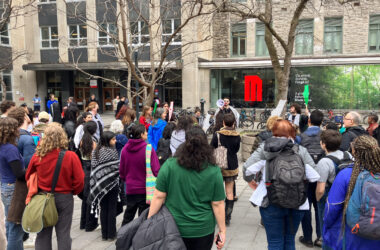You are about to undergo invasive surgery, and the anaesthesiologist begins to administer the drugs that will put you to sleep while he sits in a lab 8,000 kilometres away.
This situation is now a reality thanks to an interface developed by Dr. Thomas Hemmerling and his team from McGill’s department of anaesthesia.
Several years ago, Hemmerling created McSleepy, a software system that automatically infuses anaesthetizing drugs into patients. On August 30, his team operated the software remotely, using an Internet connection to monitor patient body signals, transmit system commands, and video chat with doctors performing the surgery abroad.
“It’s an extraordinary technological development that could be enormously useful to help with anaesthesia in remote locations,” said Fernando Cervero, director of McGill’s Anaesthesia Research Unit.
Collaborating with Dr. Cedrick Zaouter’s team at the University of Pisa, Hemmerling’s group sat at their “anaesthesia cockpit” in Montreal and anaesthetized 20 patients undergoing thyroid surgery in Italy. In addition to using automated systems, Hemmerling conducted a preoperative assessment of the patients using Skype video conferencing, including discussion of patient history and measurement of patients’ airways using rulers held by staff in Italy.
“We had two automated systems communicating with each other [and] communication was controlled through an automated system with us here in Montreal,” Hemmerling said.
From the cockpit, Hemmerling’s team gave the system commands to administer the drugs for general anaesthesia.
“The systems are specifically designed so that they deliver anaesthesia in the safest possible way, probably even safer than if you do it manually. There are many, many safety checks,” he said.
During surgery, laptops showed four video screens monitoring the surgery and various biological signals of the patients, providing doctors with the same information they would have if they were present in the room.
“If for some reason the local doctors don’t like what the automated system is doing, they can always stop it or override it,” Hemmerling said. “Even if communication breaks down, the local automated system would still function during our re-establishment of the connection.”
A particular focus of the test procedure was to determine the frequency of manual overrides or Internet misconnections. Neither problem occurred in any of the surgeries, though.
Hemmerling and other anaesthetists envision multiple potential uses for the combined technology of video conferencing and automatic anaesthesia.
“There is big incentive from the World Health Organization to develop more and more of what we call ‘telemedicine,” he said. “Transcontinental anaesthesia is definitely part of this.”
Many countries in Africa have very few anaesthesiologists. An automated system, Hemmerling said, could make anaesthesia more accessible even in remote areas.
“At this point, we do not have enough specialists in remote areas, even in Canada when you go to rural areas up north,” Hemmerling said. “Even if you are a specialist, you might have to deal with very complicated cases where you would prefer to have an automated system helping you and an expert team as a backup, with whom you can consult in real time.”
Besides helping isolated doctors, Hemmerling said he foresees the possible use of the technology as a teaching tool for training residents and for providing preoperative assessments remotely without having patients travel to the hospital.
Groups in the military and space industries have also expressed an interest in making use of the technology for surgery in locations with few or no specialist doctors available.
Steven Backman, chair of McGill’s department of anaesthesia, emphasized the novelty of Hemmerling’s process.
“You are able in real time to get a lot of biological information about the patient and also control the delivery of drugs over a long distance,” Backman said. “It’s important to bear in mind that it doesn’t replace the anaesthesiologist, but it certainly allows you to provide anaesthesia care with the input from doctors over any distance.
“We’re very excited about this,” he added. “We look forward to seeing how this is going to evolve. It’s very, very new technology.”








